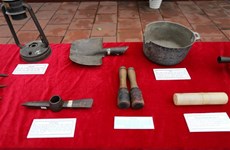Hue ancient village seductive but distant to tourists
The 600-year-old village of Phuoc Tich in central Thua Thien-Hue
province has lost half of its natural beauty, according to locals, and
the rest is under threat from road and dyke works.
The 600-year-old village of Phuoc Tich in central Thua Thien-Hue
province has lost half of its natural beauty, according to locals, and
the rest is under threat from road and dyke works.
Many even complain that the replacement of a grass road with bricks has changed the view of the village. "The brick road gives the feeling of a northern village and is unfamiliar to us," a villager said.
Hoang Tan Minh, head of Phuoc Phu, one of the two hamlets in the village, said the 1.5km road through the village was tiled with bricks in 2007.
Recently authorities from Phong Dien district built a dyke on the bank of O Lau river, which borders one side of the village. The work destroyed the village's bamboo forest and ended the use of many jetties along the river.
Cultural researchers and locals raised their voice and authorities apologised for the carelessness, but at that time the work was almost finished.
Meanwhile, many villagers are upset at rules that prevent them from repairing their houses unless it is done in the old style. They say they cannot be bothered about tourism, because little of it has happened anyway.
"Only one group of visitors has paid a visit to our village, so no one can live on promises," said Nguyen Thi Khanh Ly, co-host of the 200-year-old homes with wooden pillars and beams (nha ruong) owned by Nguyen Duy Thanh.
Locals feel the village has little service to offer visitors. "It is not enough for tourists. Visitors can only see old nha ruong," said Le Trong Dao, another villager.
The general dissatisfaction has led experts to warn that eventually, residents will modify their houses according to their own desires.
Last year, the Vietnam Institute of Arts and Culture Studies in Hue worked with the Belgian Wallonie Heritage Institute to preserve old houses and a traditional kiln. But, unfortunately, the pottery products could not find a market.
According to Nguyen Thang Long, a researcher at the institute, getting locals involved is crucial for maintaining the operation of the kiln. He said that when they saw economic benefits from the kiln, their attitudes would change.
The village is about 50km from Hue city on the national highway leading to Hanoi. It was classified as national heritage in 2009, after the recognition of old Duong Lam village in Hanoi.-VNA
Many even complain that the replacement of a grass road with bricks has changed the view of the village. "The brick road gives the feeling of a northern village and is unfamiliar to us," a villager said.
Hoang Tan Minh, head of Phuoc Phu, one of the two hamlets in the village, said the 1.5km road through the village was tiled with bricks in 2007.
Recently authorities from Phong Dien district built a dyke on the bank of O Lau river, which borders one side of the village. The work destroyed the village's bamboo forest and ended the use of many jetties along the river.
Cultural researchers and locals raised their voice and authorities apologised for the carelessness, but at that time the work was almost finished.
Meanwhile, many villagers are upset at rules that prevent them from repairing their houses unless it is done in the old style. They say they cannot be bothered about tourism, because little of it has happened anyway.
"Only one group of visitors has paid a visit to our village, so no one can live on promises," said Nguyen Thi Khanh Ly, co-host of the 200-year-old homes with wooden pillars and beams (nha ruong) owned by Nguyen Duy Thanh.
Locals feel the village has little service to offer visitors. "It is not enough for tourists. Visitors can only see old nha ruong," said Le Trong Dao, another villager.
The general dissatisfaction has led experts to warn that eventually, residents will modify their houses according to their own desires.
Last year, the Vietnam Institute of Arts and Culture Studies in Hue worked with the Belgian Wallonie Heritage Institute to preserve old houses and a traditional kiln. But, unfortunately, the pottery products could not find a market.
According to Nguyen Thang Long, a researcher at the institute, getting locals involved is crucial for maintaining the operation of the kiln. He said that when they saw economic benefits from the kiln, their attitudes would change.
The village is about 50km from Hue city on the national highway leading to Hanoi. It was classified as national heritage in 2009, after the recognition of old Duong Lam village in Hanoi.-VNA













